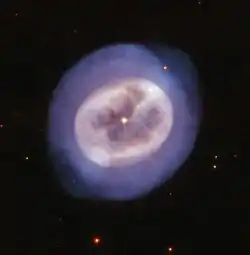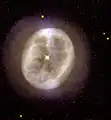NGC 2022
NGC 2022 is a planetary nebula in the equatorial constellation of Orion, located at a distance of 8.21 kilolight-years from the Sun.[3] It was first observed by William Herschel on December 28, 1785, who described it as: considerably bright, nearly round, like a star with a large diameter, like an ill-defined planetary nebula.[7] In medium-sized amateur telescopes it looks like a small grayish patch of light. It is not very bright but it is still easy to spot it in the eyepiece. Even in a telescope as small as 80mm it can just be seen using a narrowband filter such as an OIII filter as a 'fuzzy' star. The object has the shape of a prolate spheroid with a major to minor axis ratio of 1.2,[4] an apparent size of 28″, and a halo extending out to 40″, which is about the angular diameter of Jupiter as seen from Earth.[8]
| Emission nebula | |
|---|---|
| Planetary nebula | |
 | |
| Observation data: J2000 epoch | |
| Right ascension | 05h 42m 06.19056s[2] |
| Declination | +09° 05′ 10.5843″[2] |
| Distance | 8.21 kly (2.518 kpc)[3] ly |
| Apparent magnitude (V) | 11.6[4] |
| Apparent dimensions (V) | 28″[4] |
| Constellation | Orion |
| Physical characteristics | |
| Radius | 0.326 ± 0.039 ly[5] ly |
| Notable features | Double-shell |
| Designations | PK 196-10 1, IRAS 05393+0903[6] |
This is a double-shell planetary nebula with a wind-compressed inner shell and a more nebulous second shell.[9] The linear radius of the inner shell is estimated at 0.326 ± 0.039 ly. It is expanding with a velocity of 28±2 km/s. The second shell is nearly circular and is expanding more slowly than the inner.[5] The mass of the ionized elements in the planetary nebula is 0.19 M☉, or 19% of the Sun's mass.[5] A faint outer halo consists of the remains of material ejected during the central star's asymptotic giant branch stage.[10]
NGC 2022 lies 11° away from the Galactic Plane, which position suggests it was formed from a low-mass star. The elemental abundances are similar to those in the Sun, although carbon is about 50% higher and sulfur is a factor of two lower.[8] The central star of this nebula has a visual magnitude of 15.92, a temperature of 122,000 K, and is radiating 852 times the luminosity of the Sun from a photosphere that has only 6.55% of the Sun's radius.[8]
Gallery

 NGC 2022 taken at the Mount Lemmon SkyCenter (Tucson, AZ) using the 0.8m Schulman Telescope. Image courtesy Adam Block.
NGC 2022 taken at the Mount Lemmon SkyCenter (Tucson, AZ) using the 0.8m Schulman Telescope. Image courtesy Adam Block.
References
- "The Inky Abyss". www.spacetelescope.org. Retrieved 12 August 2019.
- Brown, A. G. A.; et al. (Gaia collaboration) (August 2018). "Gaia Data Release 2: Summary of the contents and survey properties". Astronomy & Astrophysics. 616. A1. arXiv:1804.09365. Bibcode:2018A&A...616A...1G. doi:10.1051/0004-6361/201833051. Gaia DR2 record for this source at VizieR.
- Stanghellini, Letizia; et al. (2008), "The Magellanic Cloud Calibration of the Galactic Planetary Nebula Distance Scale", The Astrophysical Journal, 689 (1): 194–202, arXiv:0807.1129, Bibcode:2008ApJ...689..194S, doi:10.1086/592395, S2CID 119257242.
- Finlay, Warren H. (2014), Concise Catalog of Deep-sky Objects, The Patrick Moore Practical Astronomy Series (2nd ed.), Springer Science & Business Media, p. 188, ISBN 978-3-319-03169-9.
- Sabbadin, F.; et al. (July 1984), "The planetary nebulae NGC 1535 and NGC 2022.", Astronomy and Astrophysics, 136: 193–199, Bibcode:1984A&A...136..193S.
- "NGC 2022". SIMBAD. Centre de données astronomiques de Strasbourg. Retrieved 2020-04-11.
- O'Meara, Stephen James (2011), Deep-Sky Companions: The Secret Deep, vol. 4, Cambridge University Press, p. 111, ISBN 9781139500074.
- Pottasch, S. R.; et al. (June 2005), "Abundances of planetary nebulae NGC 2022, NGC 6818 and IC 4191", Astronomy and Astrophysics, 436 (3): 953–965, Bibcode:2005A&A...436..953P, doi:10.1051/0004-6361:20042627.
- Kaler, James B., "NGC 2022 in Orion", STARS, retrieved 2020-04-12.
- Corradi, R. L. M.; et al. (April 2003), "Ionized haloes in planetary nebulae: new discoveries, literature compilation and basic statistical properties", Monthly Notices of the Royal Astronomical Society, 340 (2): 417–446, Bibcode:2003MNRAS.340..417C, doi:10.1046/j.1365-8711.2003.06294.x.
External links
 Media related to NGC 2022 at Wikimedia Commons
Media related to NGC 2022 at Wikimedia Commons